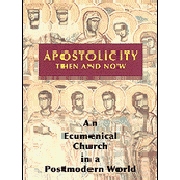
|
Posted December 2, 2004
Book: Apostolicity Then and Now Author: John J. Burkhard Liturgical Press, Collegeville, MN, pp.250 An Excerpt from the Jacket:
An Excerpt from the Book: The first result of our investigation must be the distinction between “the Twelve” and the apostles. They represent two different groups of individuals in early Christianity with two very different functions. The Twelve were the symbolic expression of Jesus’ conviction that in his proclamation of the kingdom of God theend times had begun. God was reuniting and healing the people of the covenant, and Jesus himself was inseparably a part of the process of renewal of the “true Israel.” The apostles, on the other hand, represented the emergence of a community more or less distinct from Judaism, its parent. Their function was to be the once-for-all foundations of the confession of early Christians regarding the life, death, and resurrection of Jesus and his inseparable connection with God’s kingdom in its ultimate or eschatological phase. Confusion results when we try to force these two categories of individuals — the Twelve and the apostles — into on cohesive group. Secondly, we have had to confront the wide diversity of apostles in first-century Christianity. Scholars have long known of the distinction between “apostles of the Lord” and “apostles of the churches,” but have failed to note still further distinctions among the ranks of those called apostles in the New Testament and early extra-canonical literature. In general, the impression created was that only the “apostles of the Lord” were apostles in the strict sense. “Apostles of the churches” were representatives or delegates of communities of Christians. The result has been that the other apostles mentioned throughout the New Testament have been forced into this twofold mold. In the process, the richness of the notion of apostle has gone unnoticed. The trajectories approach to ancient texts, beginning with later texts and working backward to a point of origin, has proven helpful in this context. As a result, we can distinguish between originary apostles, and between sub-apostolic and post-apostolic, and a later first-century category of apostles. We can also distinguish better between pre-Pauline, Pauline, and Lukan understandings of the originary apostles, and between sub-apostolic and post-apostolic meanings of the later apostles. Perhaps future scholars will be able to better interpret other thorny issues, namely, the possibility of women apostles in the period of originary apostles and the issue of succession to the apostles. Finally, we are now in a better position to understand the issue of office in early Christianity. The Twelve do no represent an office — use of titles, ascription of real authority, a certain permanency, the connotation of certain “rights” — but an office nonetheless. An office can be succeeded to, at least in certain respects. But the character of apostolic office in the early church also emerges more clearly. I really do not see the strictly collegial character of the group of apostles in the first century. The group of “twelve apostles,” with Peter as the head, are not a primordial form of the episcopal college with the pope a its head. But this does not mean that collegiality is altogether absent either. There was a real concern for communion among the apostles. This is unambiguously clear in the incident at Antioch involving Peter and Paul (see Gal 2:11-14), but even earlier in Paul’s concern to be at one in proclaiming the gospel with “the pillars” [of the church] (Gal. 2:1-10). Communion is more flexible and allows for greater diversity, and yet is still open to being realized in “collegial” terms. One notes communion among the apostles and subsequently among the presbyter-bishops and eventually among the threefold hierarchy of bishop, presbyters, and deacons — but this is another matter which we have yet to consider. Still, it is important to note that collegiality is adumbrated in the experience of the first century of Christianity. Table of Contents: 1. Who Were the Apostles? 2. Why the Early Churches Understood Themselves as Apostolic 3. Apostolicity in History 4. Apostolicity and Theologians 5. Apostolicity and the Classical and Modern Worldviews 6. Apostolicity in a Postmodern World 7. Apostolicity in Ecumenical Dialogue 8. Apostolicity in an Ecumenical Church |
|
